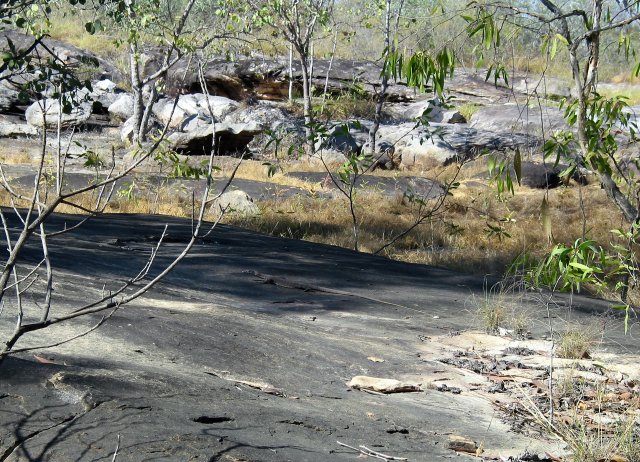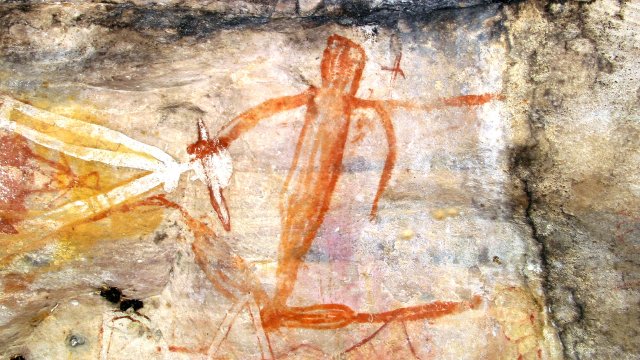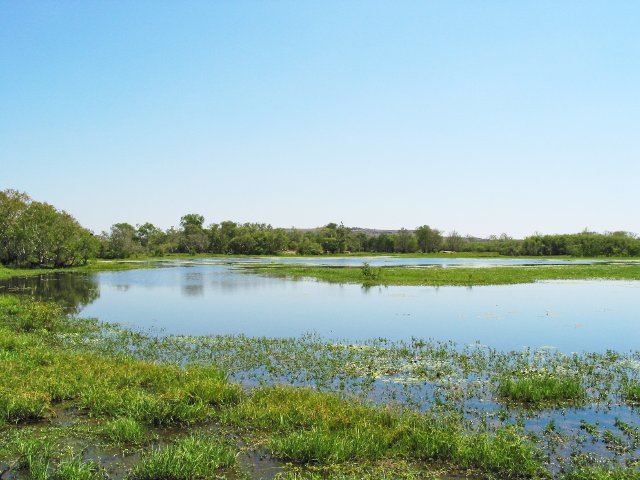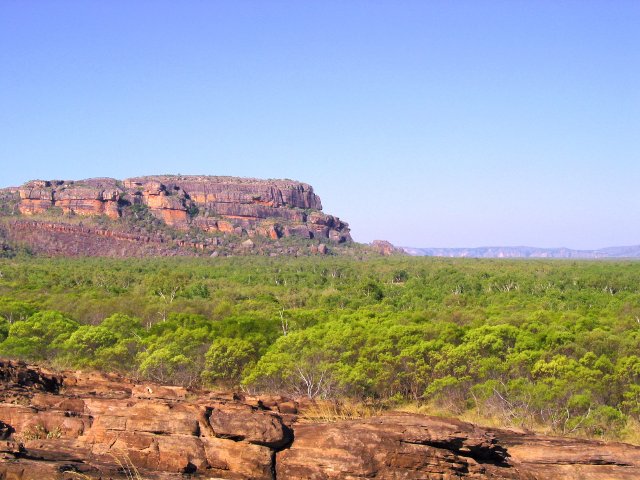Davidson's Camp to Jim Jim Campground, Northern Territory
Today: a recommendation. Davidson's Arnhem land Safaris will charge an arm and a leg to see some of the most impressive Aboriginal rock art around. It's not luxury. It's not good value for your money But it's the only way to see this level of stuff. If you're fairly interested, do it. If you're somewhat interested, avoid the $840 per day charge for two people. Yes. That's what we paid.
But, again, we saw lots of art today. And quite a few human skulls. And an incredible paperbark burial container still full of bones. Despite the outrageous price we paid, we saw some once-in-a-lifetime stuff.
Like most places in the bush, the birds wake you before the light. There was a bit of light on the eastern horizon when Chris got up and went for a predawn walk. I waited until it was light enough to read, then finished more pages of the excellent book Throwim Way Leg by Tim Flannery about his field work cataloging the mammals of New Guinea in the 1980s and 1990s. I picked the book up on a lark at the Northern Territory Museum bookshop, figuring it would be a fun read. It was much more than that--it's a fascinating study of the nature of New Guinea, with great insights into about how the native people are adapting to Western culture, and how they see the world. I particularly like his non-romantic viewpoint: this isn't about tribal people 'living in harmony with nature as they have for thousands of years', rather, many of the tribes keenly want Western goods and health care, but have no concept of things like money or government. He also doesn't pull any punches when it comes to singling out Christian missionaries as one of the most destructive cultural (and indeed biological) forces in New Guinea.
For quite awhile I've wished the anti-globalization protesters in Seattle and Genoa would target the real enemy, which is not strictly McDonald's or Hollywood but rather evangelical Christian organizations as well. Of course, if they were purists they'd add such globalized, non-democratic organizations such as Oxfam, Greenpeace, and Amnesty International to their hit list, but they won't. Some global organizations are more equal than others, it seems.
After the sun rose at 7, we packed the few things we'd taken out of the truck, and had some cereal. Our guide from yesterday, Shane, had mentioned that we were to get an early start at 7:30 with the tours... but 7:30 came and went with about half the people just starting their first cup of coffee. We were having a good old chat anyway; seems like we weren't the only ones that were a bit unimpressed with the camp. Sitting around the long breakfast table, folks joked about the pasta and tuna lunch--of course, I had to add that it was basically a $2.39 Coles Pasta Kit with a tin of tuna, which is pretty close to the truth. The bitching then started in earnest. Many (including me) were bothered that the guides just came up and said 'OK, we're going here' without asking anyone what they were interested in. I agreed with that, for sure. It was all a bit disorganized. The guides came out about then, and then said the plan for the day was to see ceremonial rock circles and rock art, taking along a lunch. We told them to have fun; we'd be leaving at lunch rather than stay another day (and thus save $840 for another adventure!)
A few of the people that had been there for five days then grumbled about going on 'yet another bloody rock art tour; haven't we seen enough already?' To his credit, our British mate John gently explained to them that perhaps everyone doesn't have the means to see everything on offer, an indirect reference to our bugging out early. I think it was a bit lost on the other group members, though.
So 8:00 rolled around, then 8:30, and we all were wondering what was happening and why the guides were just milling about. About 8:30, one of them finally explained that they were waiting for two planes to land at 7:30 and 8:30 with more guests. Aha! Chris and I were just reading books, getting more and more angry as the minutes dragged by and our wallets became rapidly lighter. I figured we were paying 58 cents a minute just to wait around, and Chris reckoned that the rate was more than it cost to call Nigeria. At 8:40 and 8:45 the two planes landed, trucks went out to meet them, the passengers were shown to their tents, the cargo of fruit and veggies was sent to the kitchen, and the main group was on their way at 9:05.
And Chris and I waited, getting more steamed by the minute.
Art sites with a little something extra
Finally, at 9:30, we were off with Jared. We went out northwest, to a series of gullies cut in the sandstone near a billabong. The first site was pretty good--there were drawings of Lightning Man and some other things, and it was an occupational site as well where Aborigines camped. On the ground were lots of shells and then I saw the skull. It was just sitting there, a few feet from the wall in the open air, on its side. The jaw was missing, so I was looking at the roof of the mouth. It was quite a shock--not one of revulsion, just one of 'whoa; this is something important, sacred'. It's not every day you see human bones, and they were everywhere. The leg bones were particularly noticeable. We looked around for some more art, and I peered into a hole in the sandstone the size of a soccer ball. A skull stared out. That was a bit creepy. Then under a shelf I spotted a skull painted red, and Jared our guide explained that the important people had their skulls painted like that.
It was all a bit strange. As I said before, this wasn't just a burial site, but a campsite. That's a bit odd; there wasn't a separate burial area, and the painting topics were fairly typical (although, of course, they were painted over several thousand years.) Jared did request that we not take any pictures of the human remains, which was fine; I took some pictures of the art on the walls above.
We then scrambled up and over some rocks to see some art up on the top surfaces of the gullies. It's hard to give a good picture of where this art is located. It's a large area, several hundred meters across, all sandstone rock, with highly eroded gullies and fissures about 5 meters deep. Many of the gullies are wide as they are deep, with acacias and other plants growing in the sand covering the gully floors. Up on top, there are odd topknots and other odd formations, and we're told a good breeze in the hot dry season. There are also quite a few grinding holes; judging by the depths of the holes people spent a lot of time up there.
And there was art. Our favorite site was under a huge boulder, supported just at two ends. Underneath the boulder was room enough for four or so people to lie down, and on the roof of the 'room' underneath was a painting of woman, with beeswax dots at crucial points like here nipples, elbows, and labia. That was great.
We also explored down below in the gullies; one camping area had some artifacts that we found intriguing: a small cutting stone, a piece of Dutch pottery, a Dutch gin bottle, and a ceramic cup. Judging by these relics, the people who lived there had obvious contact and trade with the Dutch in Indonesia, almost certainly predating British arrival by a couple of hundred years.
The most impressive thing we were shown was down in those gullies--it was a burial chamber, where I counted over a dozen skulls, and who knows how many bones strewn across a very deep cut in the gully wall. On the cut's flat floor (some 6 meters or more deep) were strewn more bones, and, up in a ceiling recess was the most incredible thing we've seen: a burial package. This was a rectangle of paperbark (which is the spongy bark of a melaleuca tree), maybe a meter and a half long by a meter wide, tied to an X of wood by some sort of cord. It looked somewhat like a tied present, or a postal package wrapped in string. The paperbark, surprisingly, was in very good shape, though there was a femur and some other long bones sticking out of one of the corners. I felt privileged to see it.
Goodbye to Davidson's, and driving through bushfire
After a brief look at a scenic billabong, we headed back to camp, where Jared made us some of the tastiest sandwiches I've ever had. We then drove back to Kakadu, a two hour drive. For the second time, we saw a bushfire in progress--but this was scarier than the one we saw on the highway of Alice Springs, because we were the only ones on the narrow road, which itself was a bit overgrown! The fire was working its way through the grass, with a definite 'front line' of flame about a meter high, though occasionally reaching two and even three meters high when it hit downed trees or other brush. I found it fascinating; birds were circling overhead looking for small prey that was either fleeing the fire or no longer had a place to hide. I also remembered a picture of a hibiscus I took yesterday. It's not there anymore, as it was right where the fire went through.
Kakadu, again
Back to Kakadu. We didn't' pass any other cars save one on our way back. It's lonely in Arnhem Land. But not in Kakadu! We first stopped at the Nourangalie site--a supposedly impressive site. After what we saw in the morning, though, it was a bit boring: after seeing one smallish area with a main picture and some minor ones, I turned to Chris and said "should we go to the main gallery?"--and Chris told me this was the main gallery; I said 'Oh.' Hm. I thought the Ubirr site and art were much more interesting.
We did go looking for the Blue Art as well. Strangely (or probably intentionally) the park information makes no mention of it. It was painted in 1964 by one of the Aborigines who worked in the area when it was a cattle station. He used laundry powder to paint, giving a blue color! Sadly, we couldn't find it, though we did have a fairly good map from an older art book the topography of cliffs and rocks and ridges got us.
Where are all the tourists?
We're not sure. Kakadu is supposed to be crawling with people. It isn't. On our walk today at Nourangalie we passed maybe ten people. We did find most of the campgrounds to be fairly full by five in the afternoon (hell, today we looked at four campgrounds before being forced by sundown to take the fairly decent bush camp by Jim Jim billabong--at least it's free!), but even then it's not like they're too overcrowded. We're just surprised.
With Davidson's camp done, we're also kinda thinking we're done with the Northern Territory. We've seen the art, we've done the walks, we've seen Darwin and various museums. We'll around until Tuesday to get our mail package, then scoot across to Western Australia and the Kimberley. Both of us aren't sure what to expect. Is the Kimberley more of the rock gorge-waterhole-rock art scene? If it is, we'll get tired of that pretty quick. There are a few things to see, though. We both want to see the Bungle Bungles. I also want to see the Horizontal Waterfalls, and wouldn't mind seeing Mitchell Falls. Chris would like to see some Bradshaw art, which is several tens of thousands of years old. And apart from that, I don't know what else we'll do. We'll see.
Weird Wildlife Sighting
Oh, plenty! I liked the 'rock art beetles', which are these intricately patterned beetles that often crawl around rock art! Also there were two rock monitors that we saw, and some regal bee eaters (?), a beautiful green and blue bird.














